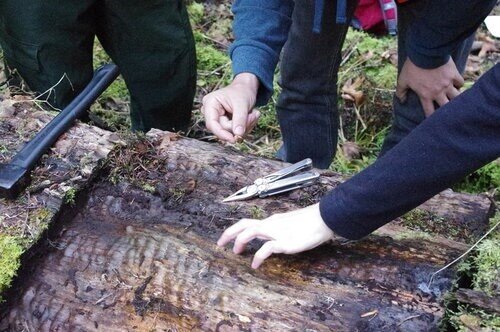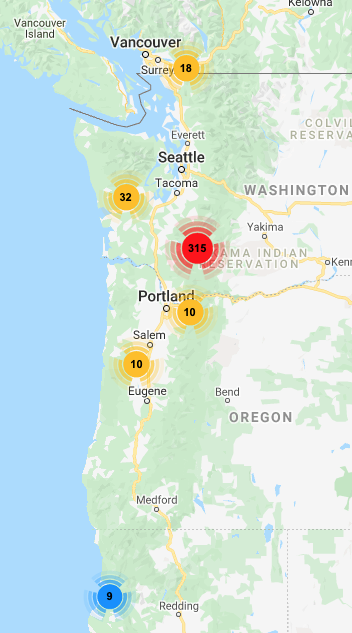Worth almost USD 152 billion a year, the illegal timber industry accounts for up to 90% of tropical deforestation in some countries and attracts some of the world’s biggest organised crime groups. It causes serious economic, environmental and social damage and fuels conflict in forest regions where criminal gangs compete for available market and with forest dwelling communities. Interpol Forest Crime Report, 14 December 2020.
“DNA fingerprinting was originally developed to identify humans and link people to crime scenes, it holds tremendous promise to help control illegal logging and can identify species, geographic origin, as well as individual trees”. Professor Andrew Lowe of the University of Adelaide and Chief Scientific Advisor to Double Helix Tracking Technologies in his article “If a Tree Falls in a forest”.
“Scientific methods such as DNA analysis can support forest law enforcement just as they have done with many other kinds of crime. WRI is working globally to help develop the scientific methods and reference databases that can combat illegal logging and associated trade worldwide.” Dr. Charles Barber, Director of the Forest Legality Initiative at World Resources Institute (WRI) quoted in the DoubleHelix case study on the Bigleaf Maple theft.
Can DNA analysis and forensic science be used to fight environmental crimes – like illegal logging and illegal timber trade – in the same way they have solved serious crimes of the human kind?
Certainly. But like police detective work, which involves dogged determination, searching for clues and pouring over evidence, solving and preventing forest crime means engaging the expertise of scientists to work both in the field and in the laboratory.
Just as sharing DNA evidence that led to the successful resolution of one criminal case can help solve other crimes, that’s exactly what Double Helix Tracking Technologies (DoubleHelix) is prepared to do now that a new platform has been established by Global Timber Tracking Network (GTTN).
GTTN exists to promote the use of innovative tools for species identification and for determining the geographic origin of wood to verify trade claims. It supports the researchers who develop the tools, forest and timber industries which exercise due diligence, and law enforcement agencies in the fight against illegal logging and related trade around the globe.
Primarily it has been created for wood identification experts to find and share information on wood samples and reference data. The minimum requirement for participating laboratories is to share metadata, which describe the tree species, geographical origin, and laboratory method. This information will be visible to any participating laboratories.
In the best case, GTTN explains, labs are willing to share vouchered physical wood samples, or even reference data.

There’s an assurance from GTTN that at any time participating laboratories have full control over what information they share – and who they share it with – particularly if intellectual property (IP) rights are involved. Data owners and interested parties can take care of necessary formalities directly between them, before opening data access through the reference database.
Darren Thomas, CEO of DoubleHelix, strongly believes that much more can be done to prevent and reduce the prevalence of forest crime, and by providing the first complete, open-access genetic dataset on the GTTN platform, it will help others do a better job.
“Sharing a detailed description of how we did it – using DNA testing and other tracing techniques, along with many other data collection methods – enables others to benefit.
“DoubleHelix very much supports the idea of open source access to scientific data which the GTTN platform represents. That’s why we are very happy to see that one of ours is the first complete dataset uploaded.” Mr Thomas says.
Along with the University of Adelaide, DoubleHelix is a pioneer in the use of DNA analysis to verify timber species and origin. Their expertise has been called on to undertake this sort of work across five continents to date, and they realise that to deal with the very serious global problem of illegal trade in timber, more forensic labs need to be involved.
“We see it as our responsibility to share what we have to help others do this essential work, says Mr Thomas. “Any lab that has the necessary equipment and expertise to extract DNA, to sequence it and analyse it, can use this data themselves, either for research purposes or for enforcement efforts.”
For the record, the UN Environment Programme estimates that globally 15 – 30% of timber is taken illegally. To get a current value on this criminal activity, see the December 2020 Interpol Report on Forest crime:
“Worth almost USD 152 billion a year, the illegal timber industry accounts for up to 90% of tropical deforestation in some countries and attracts the world’s biggest organised crime groups. It causes serious economic, environmental and social damage and fuels conflict in forest regions where criminal gangs compete for available markets.“
The first complete set of data on the GTTN platform is related to bigleaf maple, covering the Pacific NorthWest of the United States. This data was developed through collaboration between the US Forest Service, DoubleHelix, the University of Adelaide, and with funding from WRI.
While much has already been written about “The Case of the Meth Maple Guitar”, as this was the first time DNA techniques were used to help solve a forest crime (in 2016), now much more detailed data on how this was done is going on the GTTN platform.
DoubleHelix and the University of Adelaide strongly believe that by openly sharing all the data and details of how they solved one forest crime will help stop others in their tracks.
More than 400 bigleaf maple trees were sampled and analysed to build a DNA fingerprint database that would enable experts to match seized logs to the stumps of bigleaf maple trees in the United States’ Gifford Pinchot National Forest in 2006. This was the first forest crime solved using DNA sampling, and the full data set is now available through the Global Timber Tracking Network (GTTN) for other forensic labs to access.

So why is the wood species at the heart of the first successfully prosecuted forest crime called “Meth Maple”? In the Pacific Northwest of the US, this valuable wood is cut down in protected forests by drug addicts and sold on the black market for a quick source of cash to buy drugs.
Professor Andrew Lowe of the University of Adelaide and Chief Scientific Advisor to DoubleHelix, says that he could see that while DNA forensics was originally developed to identify humans and link people to crime scenes, it holds tremendous promise to help control illegal logging and can identify species, geographic origin, as well as individual trees.
Using these techniques for the first time (in 2016), a map of genetic variation was generated for bigleaf maple around the Gifford Pinchot National Forest in Washington State, the main crime scene, and extending up to Canada and down to northern California.
The analysis included recently felled stumps in national parks and pieces of timber seized from a local timber yard that was suspected to have been trading in illegally sourced timber.
In the end, says Prof Lowe, a total of 394 individuals were DNA fingerprinted using 128 single nucleotide polymorphisms, or independent DNA fingerprinting gene regions.
Using these markers, the exclusion probability – the chance that two trees shared the same genotype – was calculated as 1.785 × 10−25.
“There are only 1021 stars in the universe and only 3 trillion (1012)trees on earth, so the chance that two of these trees shared the same DNA fingerprint is infinitesimally small or almost impossible,” says Prof Lowe.
DNA fingerprinting matched several of the pieces of wood seized from the sawmill back to one of the felled stumps in Gifford Pinchot National Forest. This evidence led to four defendants in the case pleading guilty and being sentenced to fines and/or jail terms.
The prosecutions were made under the Lacey Act, a law specifically designed to stop the illegal trade of wildlife and timber. This was the first time that the Lacey Act had been applied to a case of domestic illegal logging, and the first case in the world where DNA forensics was used to trace the origin of illegally logged timber.
What more could a forensics lab or forest crime researcher lab learn from the GTTN platform?

For a start, there is an interactive map showing the location of all 394 samples utilised in bigleaf maple study.
Additionally, there are three more data files that can be downloaded to approved parties:
latitude/longitude data for each sample,
genotype data for each sample, and
MassArray design file used to set up for the analysis with the markers developed for this case.
All this and more is now on the GTTN platform. As this case led to a significant rethink across the timber industry in the US, these methods are now being implemented to control illegal logging across a range of global timber supply chains.
They are also now recommended by the United Nations Office of Drugs and Crime for controlling and prosecuting cases of illegal logging.
The organisation Earthsight identified three main problems that have caused the loss of revenue and ecological threats:
the circumvention or ignoring of the environmental regulation,
the use of “ghost employees” and
the illegal exports that drive down legal timber prices.
This situation worsens in developing countries that are prone to corruption, where authorities have been found to often be ineffective in auditing supply chains and certifying compliance with regulation and additional standards.
But as with any exercise in sharing information, DoubleHelix and others in the DNA game have to be careful that it doesn’t get into the wrong hands.
So while Prof Lowe of University of Adelaide and DoubleHelix clearly advocates open source so others can benefit from the DNA fingerprinting to solve forest crime, the GTTN platform is secure, so only legitimate forensic labs and scientists can access the detailed data sets.
The last word goes to WRI, which is also one of the global organisations behind the setting up of GTTN:
“Scientific methods such as DNA analysis can support forest law enforcement just as they have done with many other kinds of crime. WRI is working globally to help develop the scientific methods and reference databases that can combat illegal logging and associated trade worldwide,” said Dr Charles Barber, Director of the Forest Legality Initiative at WRI.


